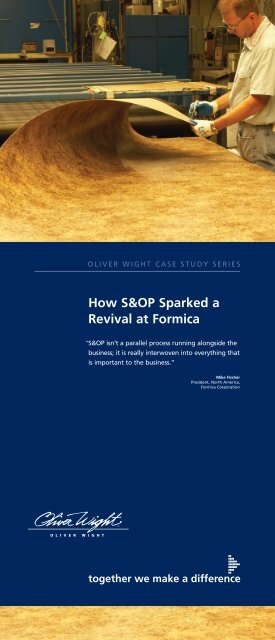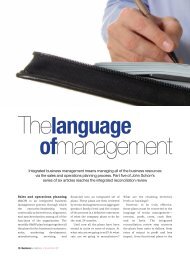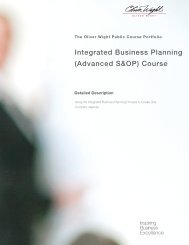Formica Case Study S&OP - Oliver Wight Americas
Formica Case Study S&OP - Oliver Wight Americas
Formica Case Study S&OP - Oliver Wight Americas
Create successful ePaper yourself
Turn your PDF publications into a flip-book with our unique Google optimized e-Paper software.
OLIVER WIGHT CASE STUDY SERIES<br />
How S&<strong>OP</strong> Sparked a<br />
Revival <strong>Oliver</strong> <strong>Wight</strong> at <strong>Formica</strong><br />
Courses & Workshops<br />
“<br />
S&<strong>OP</strong> isn’t a parallel process running alongside the<br />
business; it is really interwoven into everything that<br />
January - December 2003<br />
is important to the business.”<br />
®<br />
Mike Fischer<br />
President, North America,<br />
<strong>Formica</strong> Corporation<br />
together we make a difference
<strong>Formica</strong> Corporation<br />
Highlights:<br />
“Sales and Operations Planning is our most important initiative this year,” Mike<br />
Fischer, President, North America, <strong>Formica</strong> Corporation, proclaimed throughout<br />
2005. He visibly and actively championed the concept by repeating this mantra<br />
continuously and regularly referencing it in his quarterly business updates to the<br />
<strong>Formica</strong> family. Most importantly, however, is that he acknowledged and<br />
accepted ownership of <strong>Formica</strong>’s formal S&<strong>OP</strong> process.<br />
Within the first year after beginning their S&<strong>OP</strong> implementation, the<br />
achievements reported by <strong>Formica</strong>’s teams are impressive:<br />
• 93% forecast accuracy at year end, a significant improvement;<br />
• 90+% in many of their warehouses, up from 75%;<br />
• 85+% Available-to-Promise First Date, an increase from less than<br />
70%;<br />
• 11% inventory reduction in its core laminate business;<br />
• EBITDA in excess of 10%; and<br />
• Sales in excess of 5%.<br />
In addition to these accomplishments, there has been a significant improvement<br />
in communications within and<br />
among the various business<br />
organizations. <strong>Oliver</strong> <strong>Wight</strong><br />
consultant Jon Minerich agrees,<br />
“As we went through the S&<strong>OP</strong><br />
transformation, there was a<br />
noticeable cultural shift as the<br />
communication and teamwork<br />
dramatically changed. People<br />
began working as a team; they<br />
now are cooperating and have<br />
confidence in each other, and<br />
they are communicating more.”<br />
The compelling reason leading to S&<strong>OP</strong><br />
<strong>Formica</strong> Corporation, headquartered in Cincinnati, Ohio, is a leading global<br />
designer and manufacturer of decorative surfacing materials for commercial<br />
and residential applications. Products include high pressure laminates, solid<br />
surfacing, and other decorative surfacing products, including granite and<br />
quartz. In North America the privately-held company has four manufacturing<br />
facilities and eight distribution centers. It also has manufacturing plants,<br />
warehouses, and customer service centers located throughout Europe and<br />
Asia, including Mainland China.<br />
One of the issues confronting <strong>Formica</strong>, not unlike many other companies,<br />
was the functional silos that had built up over the years, negating any<br />
meaningful communications, especially between demand and supply.<br />
Another was the uneven performance in service to the customer. This was
due, in part, to the existing business process that primarily focused on what<br />
was happening currently, that month, and relying on an unreliable forecast<br />
for the next month.<br />
“When I became president almost two years ago,” Fischer explains, “we<br />
formed the North American Business Team (NABT) with all of the functional<br />
vice presidents, many of whom were new to <strong>Formica</strong>, to meet every week to<br />
make sure that we’re all on the same page, working together, and driving<br />
the operation correctly and meeting our numbers.” This started to move the<br />
company in a positive direction, albeit at a very high level. However, Fischer<br />
acknowledged, “We were not able to make the cultural change in middle<br />
management and below to have this better teamwork and communication.”<br />
This recognition led to the investigation of S&<strong>OP</strong> as a process to “move us<br />
forward.” One of the first actions taken, and which Fischer strongly<br />
recommends, is the appointment of a full-time project leader whose primary<br />
responsibility is to be fully involved with and drive the S&<strong>OP</strong> initiative.<br />
Jim Mintzer, a Regional Sales Manager and <strong>Formica</strong> veteran, was named<br />
S&<strong>OP</strong> project leader. While familiarizing himself with S&<strong>OP</strong>, Mintzer<br />
interviewed consulting firms to learn what is involved with the process and<br />
what he needed to do to lead the project. “I selected <strong>Oliver</strong> <strong>Wight</strong> because<br />
they were responsive to my needs, reliable, and we could relate to them,” he<br />
said.<br />
Changing the culture at <strong>Formica</strong><br />
<strong>Formica</strong>’s S&<strong>OP</strong> initiative consists of five distinct, yet interrelated processes:<br />
new product planning; demand planning, supply planning, financial<br />
planning, and executive (NABT) planning, all of which look ahead 60 days<br />
and beyond.<br />
In addition to these five meetings each month, other sub-level meetings<br />
occur within each area to provide necessary information and data to the<br />
monthly demand, supply, or other planning meeting.<br />
“The S&<strong>OP</strong> initiative was just as much a culture change as it was a process<br />
implementation,” Mintzer explains. “Most people throughout the<br />
organization really didn’t know about S&<strong>OP</strong>, what it meant, and how it was<br />
going to help the company.”<br />
Mintzer began the education process by sending letters to all employees in<br />
which he defined and explained the S&<strong>OP</strong> concept and process. He also<br />
constructed a diagram of the S&<strong>OP</strong> cycle, and by focusing on the demand<br />
side, indicated all of the inputs and where they originated, and related how<br />
that information would be used, its importance, and how the results would<br />
then be transferred to the supply side.<br />
Mintzer next assembled a cross-functional team of individuals from <strong>Formica</strong>’s<br />
North American facilities who would become the core leaders of the process.<br />
They received intensive training from Mintzer and <strong>Oliver</strong> <strong>Wight</strong> consultants,<br />
as did the executive (NABT) team who owned the process.
The demand planning process received a great deal of focus by Mintzer and<br />
Minerich. Today, a sophisticated forecasting process is in place providing<br />
meaningful—and insightful—information.<br />
One significant change in demand planning was to engage the regional sales<br />
managers in the forecasting process; the other was to create a demand<br />
planning manager position. Among other responsibilities, the demand<br />
planning manager confers with each regional sales manager for about 90<br />
minutes each week gathering appropriate input.<br />
Each regional sales manager now provides information about product<br />
families, as well as types of finish and grade, during the demand planning<br />
meeting. “We now drill down to a level that is more finite than our<br />
managers have ever managed before,” Sid Adler, Vice President of Sales,<br />
North America, states.<br />
But most important, Adler explains, is that each regional sales manager now<br />
must publicly state in front of their peer group that they own the forecast<br />
they just made. Should a change become necessary, they affirm they will<br />
notify the demand manager who can then incorporate the change into the<br />
demand signal sent to the supply organization.<br />
Rick Kerrigan, Vice President, Global Supply Chain, together with Adler,<br />
defined the appropriate signal, or the common denominator, to be sent from<br />
demand planning to supply planning. “We receive a signal from sales of<br />
finish and grade level by region in square feet,” Kerrigan explains. “That<br />
allows us to go through our rough-cut capacity, look at our loading on our<br />
plants, and put it into another template to provide the plants the outlook<br />
signal for the next 30, 60, 90 and 120-plus days.”<br />
Kerrigan notes that while there is still a void, that is, the SKU demand at the<br />
plant level, the signal received from sales today “essentially makes sure that<br />
in the 60-plus day outlook, we don’t run into a bottleneck with plates,<br />
starting up or shutting down a major press, and that we have the right<br />
inventory levels within our plants or at least in the distribution centers.”
The financial planning part was the slowest to be integrated as there was no<br />
alignment between what the S&<strong>OP</strong> numbers showed and what the financials<br />
showed. However, Robert Goss, Vice President, Finance, mentioned that for<br />
the 2006 budget, the two sets of numbers are aligned and that the budget<br />
has more detail than any previous business plan. However, he cautions, “We<br />
need to make sure that we keep that alignment and that the forecast is<br />
realistic.”<br />
Mintzer, who has been promoted to General Manager, Hard Surfaces,<br />
maintains, “We’re maturing in our process, and it’s getting better every<br />
month.” Attesting to that is the plan to expand the S&<strong>OP</strong> process into other<br />
product categories (solid surfaces, stone and granite) that are smaller<br />
businesses with less infrastructure. There is talk about introducing S&<strong>OP</strong> to<br />
<strong>Formica</strong> operations in Europe and Asia.<br />
What is Sales & Operations Planning?<br />
Sales & Operations Planning is a process developed by <strong>Oliver</strong> <strong>Wight</strong> and led<br />
by senior management that, on a monthly basis, evaluates revised, timephased<br />
projections for supply, demand and the resulting financials. It’s a<br />
decision-making process that ensures that the tactical plans in all business<br />
functions are aligned and are in support of the business plan.<br />
The objective of S&<strong>OP</strong> is to reach consensus on a single operating plan that<br />
allocates the critical resources of people, capacity, materials, time, and<br />
money to most effectively meet the marketplace in a profitable way.<br />
<strong>Case</strong> study kindly authorized for publication by <strong>Formica</strong> Corporation.
<strong>Oliver</strong> <strong>Wight</strong> <strong>Americas</strong>, Inc<br />
52 Newport Road, New London<br />
New Hampshire, 03257, USA<br />
Telephone: 1 800-258-3862<br />
1 603-526-5800<br />
Facsimile: 1 603-526-5809<br />
info@oliverwight.com<br />
www.oliverwight.com<br />
<strong>Americas</strong><br />
52 Newport Road, New London<br />
New Hampshire 03257, USA<br />
Europe, Africa & Middle East<br />
The Willows, The Steadings Business Centre<br />
Maisemore, Gloucester GL2 8EY, UK<br />
Asia/Pacific<br />
Suite 2, 15 - 17 Forest Road, Hurstville<br />
N.S.W. 2220, Australia<br />
®

















